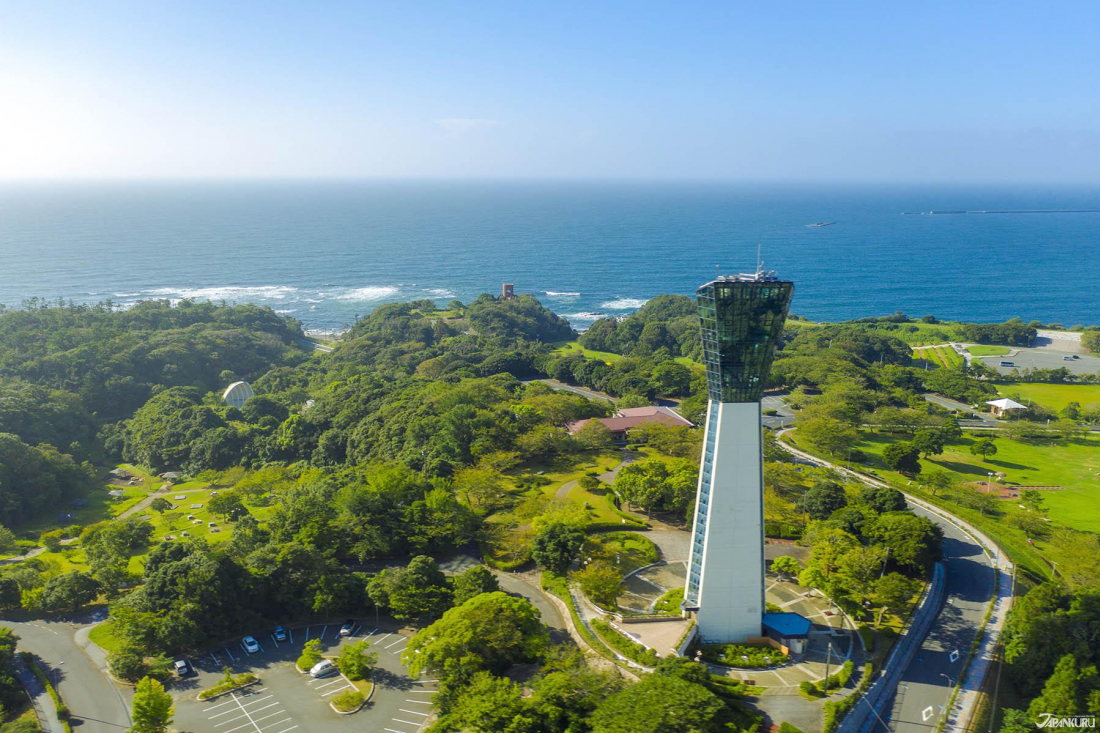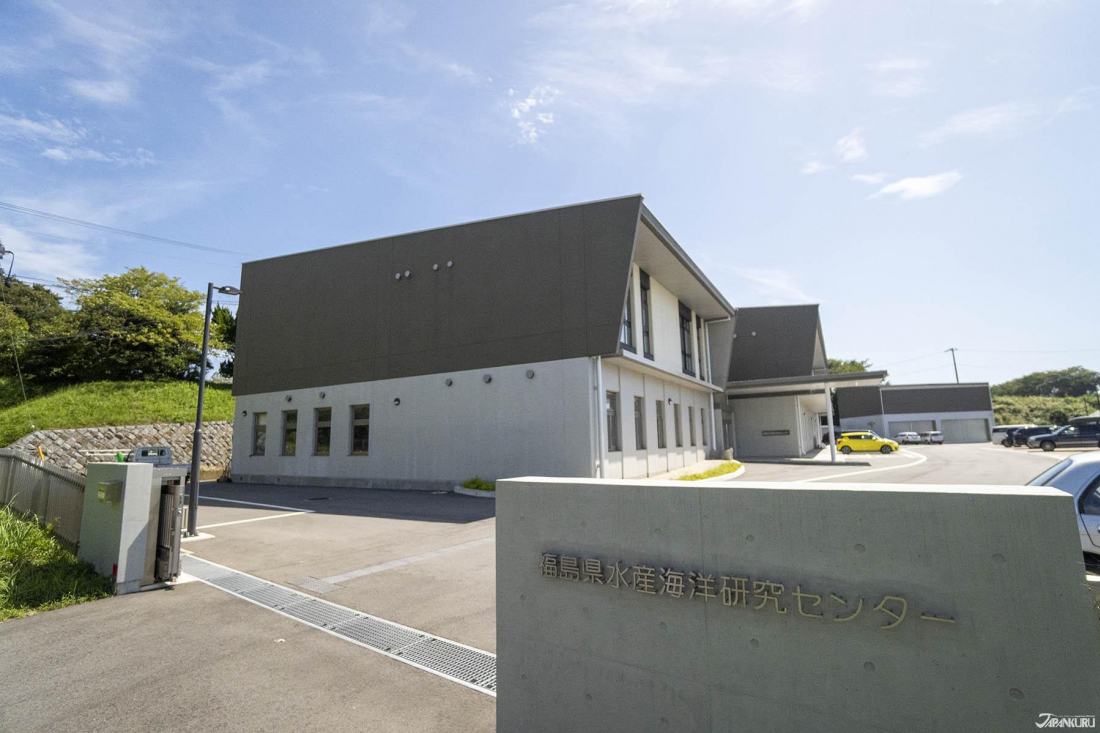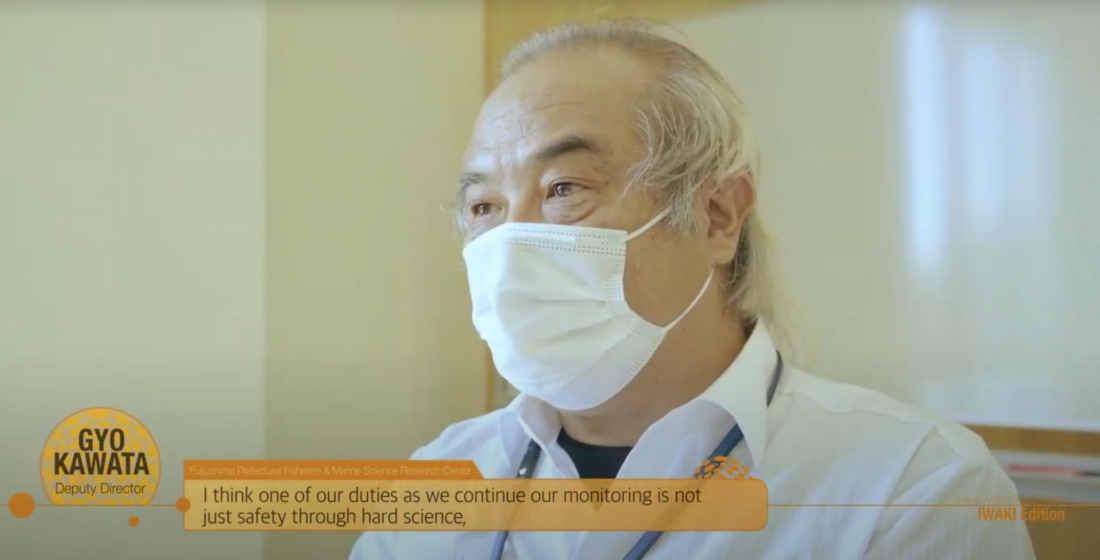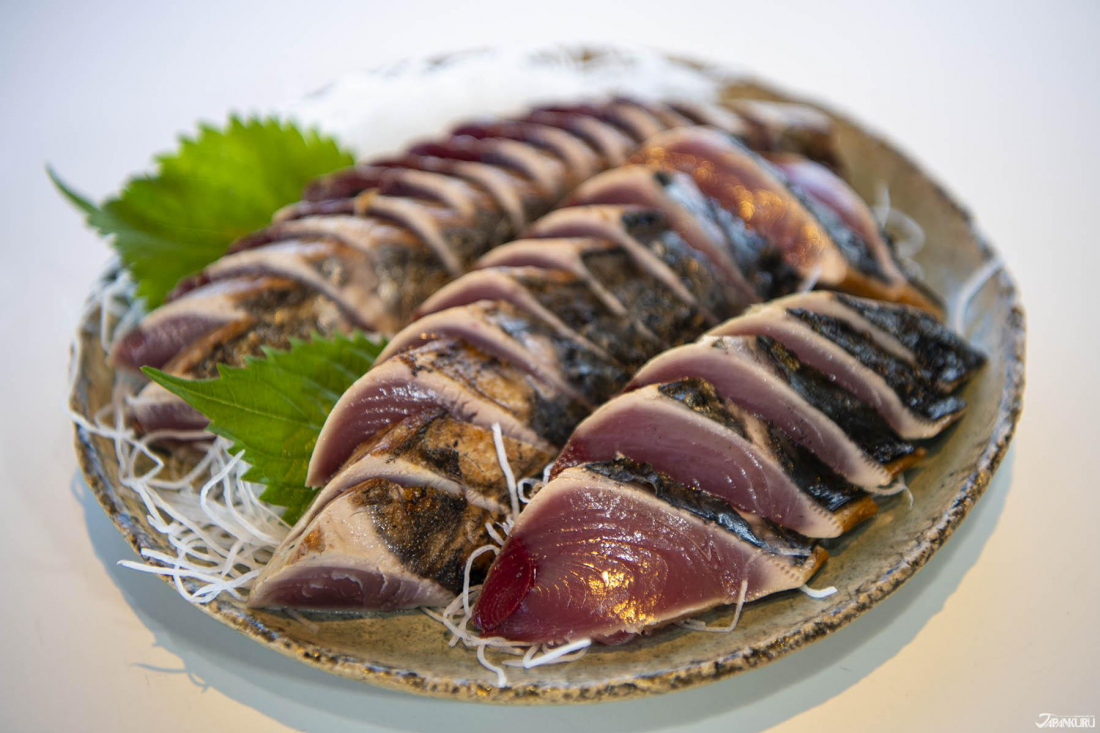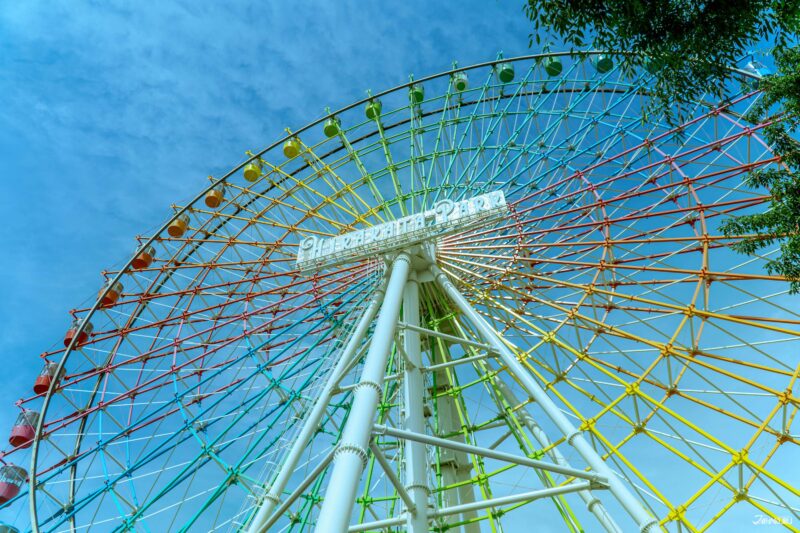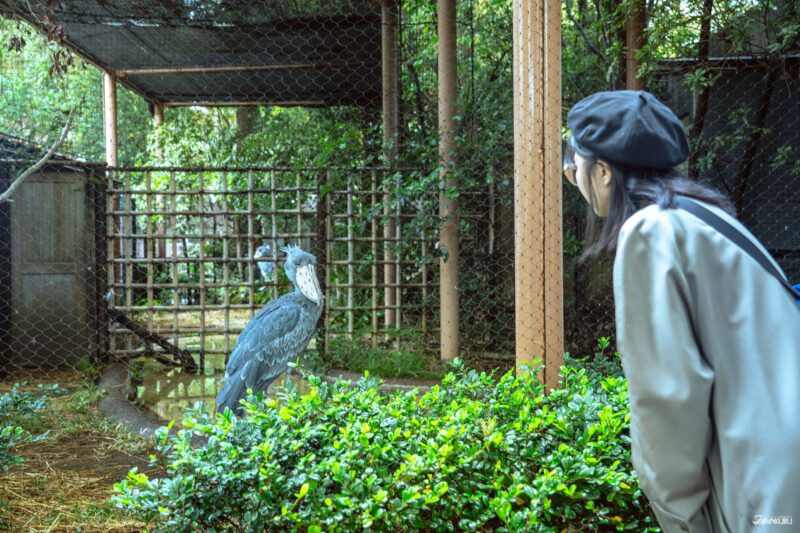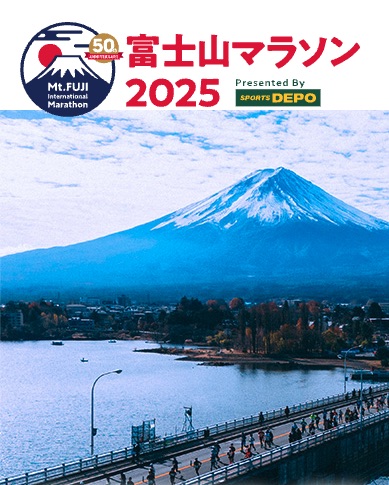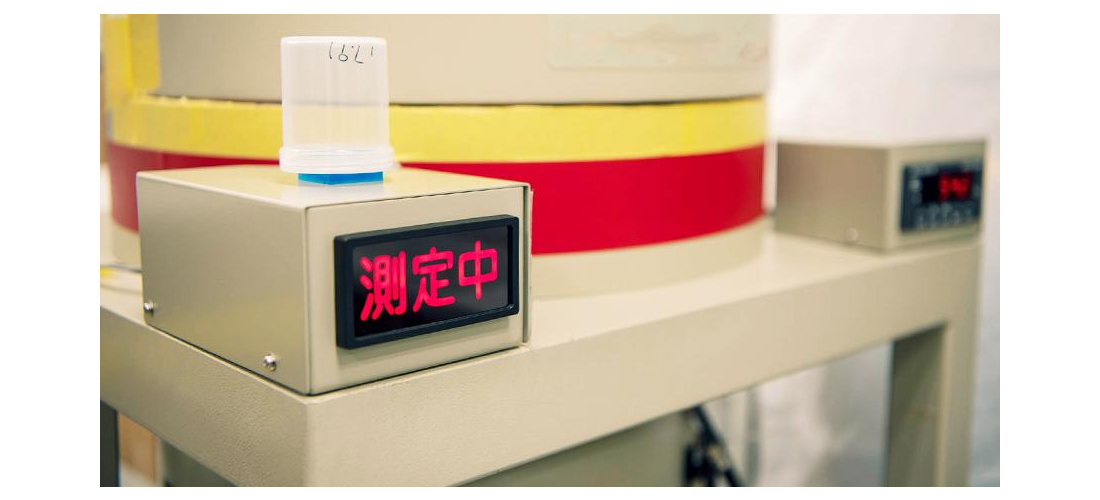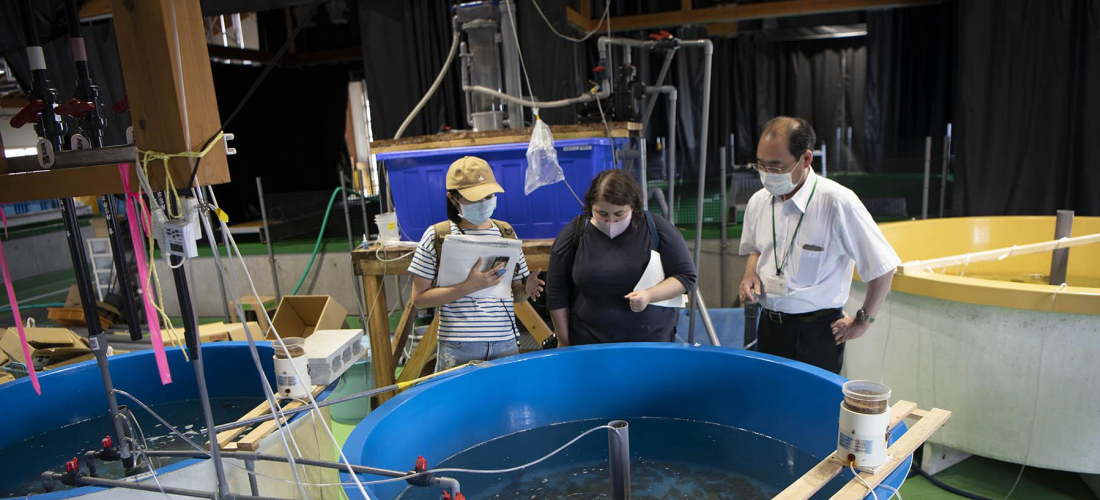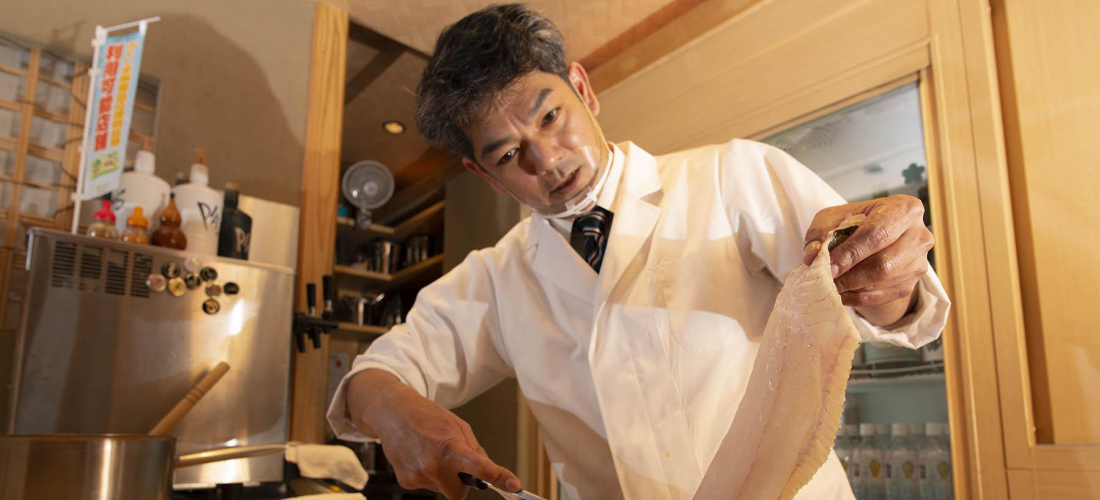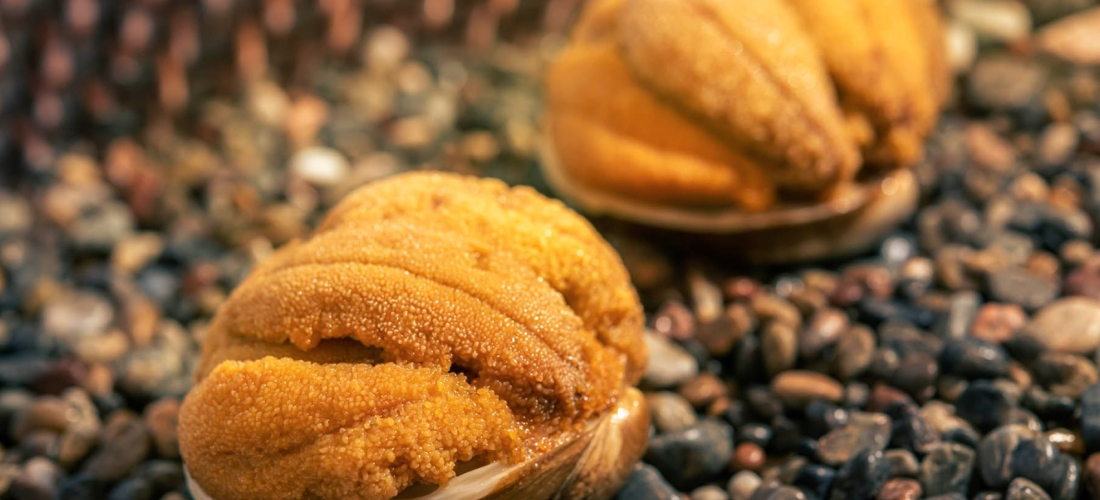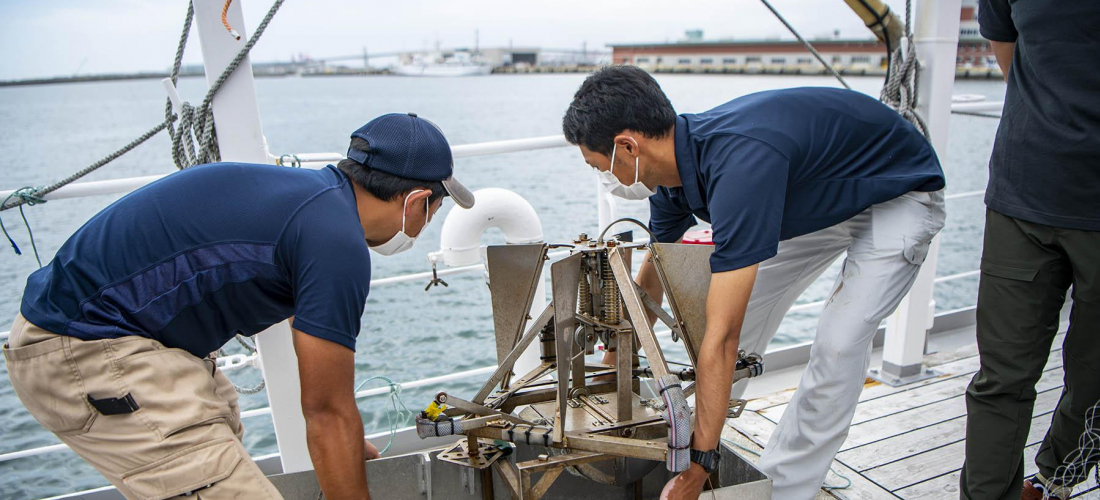
CONTENTS
On March 11th, 2011, the Tohoku earthquake set off an enormous tsunami that assailed the Fukushima Daiichi Nuclear Power Plant, causing serious damage to the ocean off the coast. In the ten years since then, Fukushima’s local government and fishery workers have come together to try and restore the once famous fishing grounds of the “Shiome Sea,” performing monitoring tests, screening tests, and continuing research on the local research environment at the Fisheries and Marine Science Research Center.
Is Fukushima’s Ocean Safe? Answers from the Fisheries and Marine Science Research Center
In previous articles from our Joban-mono series, we've discussed the safety of fish and other marine products in Fukushima today, and hopefully we've provided a basis for understanding the monitoring and screening tests that ensure food safety throughout the prefecture. Thanks to the hard work of Fukushima's fishery workers, the fishing industry is growing again, and people around Japan are once again finding confidence in Fukushima's famous Joban-mono seafood.
Fukushima Prefecture isn't just looking at the radiation levels in fish and seafood, however. The prefecture is constantly monitoring and investigating any changes in local radiation levels, along with the status of the local undersea environment, including both seawater and the sediment on the sea floor. This scientific research and the resulting data form the scientific basis for reports that the ocean off of Fukushima's coast has returned to safety in the years following the nuclear disaster, and these scientific results are connected to the revival of Fukushima's fishery businesses. This research, and the scientists who carry it out, can be found at Fukushima Prefectural Fisheries and Marine Science Research Center, next to Misaki Park in the city of Iwaki.
In 2018, the Fukushima Prefectural Fisheries and Marine Science Research Center was reorganized and renamed, and in 2019 it was reestablished as the center it is now, with an increased focus on radiation research. The facility is at the core of Fukushima Prefecture's fishery research and testing, together with institutions like Soma's Research Institute of Fisheries Resources and the Fukushima Prefectural Inland Water Fisheries Experimental Station in Inawashiro, which all study the current status of Fukushima's ocean waters, rivers, and lakes, performing a vital role in Fukushima's projects for rebuilding the local fishing industry.
The Fisheries and Marine Science Research Center is split into three departments, focusing on the marine fishing industry, the fishing grounds environment, and radiation research. Focusing in on the theme of Joban-mono, when the Japankuru team visited the center, we spent our time with the Radioactivity Research Department. This department investigates and studies radioactive material affecting the fishing industry and the local marine environment, any connections that could be found between the radiation and local marine life ecology or distribution, and the changing concentrations of local radioactive material over time.
Testing Marine Organisms for Radiation (Monitoring Tests)
In our previous article on monitoring and screening testing, we went over all the work done at the Fukushima Agricultural Technology Center to monitor agricultural and marine products. Scientists at the Fukushima Prefectural Fisheries and Marine Science Research Center perform sample collection and preparation for Fukushima's monitoring tests, along with analysis of the data that comes from those same tests. The results and analysis accumulated at the center is used for research concerning the radiation in fish caught in the region of Fukushima's coast (the Sanriku Coast), and also used to identify potentially important anomalies in smaller regions along the coastline.
To measure and test for radiation, the Fisheries and Marine Science Research Center is equipped with high-precision high-spec machines, and the center maintains a research vessel that surveys the local marine environment and investigates fishing grounds. The center doesn't just receive fish samples from fishing boats, they also use the research vessel to retrieve samples for monitoring tests and research.
Red: Percentage of Sample Exceeding 100Bq/kg
Blue: Percentage of Sample with No Radiation Detected
The monitoring results from the Fukushima Prefectural Fisheries and Marine Science Research Center and Fukushima Agricultural Technology Center, along with related research data, is collected and released to the public in the form of lectures and Fukushima Prefecture web pages, featuring simple graphs and easy-to-understand information. During our visit as well, Radioactivity Research Department head Kyoichi Kamiyama explained the work they were doing using a variety of graphs and helpful data, including the graph shown above. After the Tohoku earthquake, a majority of the sea creatures caught off the coast of Fukushima showed radiation levels exceeding Japan's standard safety limit (100Bq/kg), reaching over 90% of samples tested. But as time goes on, radiation levels and the number of samples showing results over 100Bq/kg have both decreased. Since April of 2015, the concentration of radioactive material in fish samples has fallen below 100Bq/kg, and since 2019, 99.8% of the samples tested have had so little radioactivity, test results have come back as "not detected."
Testing Seawater & Seafloor Sediment for Radiation (Monitoring Tests)
The ocean is an enormous ecosystem, but small organisms like plankton and larger organisms like fish are closely connected. At the Fisheries and Marine Science Research Center, not only do they monitor larger marine creatures, but they also research and study the environment those creatures inhabit. The Iwakimaru, the research vessel maintained by the center, regularly cuts across the local ocean to collect seawater and seafloor sediment samples, to bring back to the lab and analyze.
According to the Fisheries and Marine Science Research Center data, the concentration of radioactive material in the local seawater quickly dropped after the nuclear disaster, and since November 2012―less than 2 years after the radioactive material was released―concentrations of radioactive cesium-137 in seawater collected off of Fukushima's coast measured in at under 1Bq/L. When it came to seafloor sediment, the researchers already knew before the disaster that it was unlikely to have much of an effect on marine life, but when high concentrations of radioactive material were found in seafloor sediment after the nuclear meltdown, they began monitoring that as well. They've found that as time goes by, the concentration of radioactive material in the seafloor sediment has gradually lessened as well.
Indispensable in all of this work is the fishery research vessel the Iwakimaru, so of course the Japankuru team headed down to the water and hopped aboard the boat. Take a look at the Iwakimaru―she's not a fishing boat, but she's at the heart of Fukushima's fishery restoration projects!
The Iwakimaru – The Fisheries and Marine Science Research Center Fishery Research Vessel
The bright white Iwakimaru just about gleams under the blue skies at Onahama harbor, where the vessel is anchored when she's not in use. This generation of the Iwakimaru is apparently the 9th in a line of Iwakimarus, and went into service in fall 2014, after the previous Iwakimaru was apparently scrapped when it sank in the aftermath of the 2011 Tohoku earthquake and tsunami. But the 9th-generation Iwakimaru has inherited the same purpose as its predecessors, and is equipped with gear and observational equipment for collecting marine life specimens and with facilities for sampling radioactive material concentration in the seawater and seafloor sediment, all contributing to Fukushima's fisheries.
Compared to previous editions, this Iwakimaru has an even more important mission, because the vessel isn't just surveying the marine environment and fishery resources, she's also investigating radiation in marine life, and what the environment is like after the 2011 disaster. The Iwakimaru has a variety of nets for different areas of ocean onboard, so taking a sample even from deep in the ocean is no problem, and of course seawater and seafloor sediment sample collection is an everyday occurrence. The boat makes the rounds and collects samples from a number of monitoring points.
All kinds of information is displayed on the vessel's many screens, a sign of the many sensors onboard, from radar scans and sonar, to GPS and screens showing the positioning of schools of fish. The CTD on the Iwakimaru detects salinity, temperature, and depth, which it converts into a digital signal and sends to the boat's computers via cable, giving the researchers aboard the ship a way to better observe the ocean waters. The CTD also comes with sampling bottles for collecting seawater, which is then brought back to the lab for further investigation.
Using Scientific Data for Better Understanding
At the end of our interview with Fukushima Prefectural Fisheries and Marine Science Research Center Deputy Director Gyo Kawata, he told us "it's important to continue radiation monitoring tests, but it's hard to reassure people just by collecting scientific data. For us, how to best communicate this information is a difficult question." Scientific data can be used to visualize radiation, which is invisible to the naked eye, but in the end the hard data isn't enough to move people. What's important is using the data to convince people, and help them understand what it means. As Radioactivity Department head Kamiyama explained to us, 99.8% of results of Fukushima monitoring tests now come back as "radioactive material not detected"―an important statistic. Kawata insisted that both continuing to monitor radiation and also sharing these kinds of results is extremely important.
Reflecting on the research center's plans for revitalizing Fukushima's fisheries, Kawata explained that protecting and managing local marine resources, avoiding overfishing, and continuing to monitor for radiation were all vitally important. Most important, though, was communicating and spreading information from person to person, whether those people are fishery workers or everyday consumers. Kawata also mentioned that he hoped to introduce ICT technology and machines for measuring fish freshness and fat content to the lab. Publishing that kind of data, he said, might help people understand Fukushima's fisheries more deeply. "This our own little dream that we hope to make a reality," he explained. "Visualizing the data makes it easier for consumers to take in, so whatever happens, we're hoping to secure the budget to put our plans into motion," he finished with an excited smile.
The Fukushima Prefectural Fisheries and Marine Science Research Center and the Iwakimaru don't just collect scientific data on Fukushima's fishing industry and marine environment―the researchers are clearly passionate about their work, as they help protect Fukushima's seas and maintain marine products. Not only do they know what they're talking about when they explain the details of their research, but they patiently persevere when it comes to communicating their important work to the world, and they certainly made sure that every member of the Japankuru team walked away from the research center with a better understanding.
In the next article of our Joban-mono series, we'll be looking at a different group of researchers a little up the coast, who work to tackle a different set of projects for Fukushima's fishing industry at the Fukushima Prefectural Research Institute of Fisheries Resources in Soma. Can their work on fish farming support the revitalization of Fukushima's fisheries? Find out more in part 8!
Details
NAME:Fukushima Prefectural Fisheries and Marine Science Research Center
COMMENT
FEATURED MEDIA
VIEW MORE 
A New Tokyo Animal Destination: Relax & Learn About the World’s Animals in Japan
#pr #japankuru #anitouch #anitouchtokyodome #capybara #capybaracafe #animalcafe #tokyotrip #japantrip #카피바라 #애니터치 #아이와가볼만한곳 #도쿄여행 #가족여행 #東京旅遊 #東京親子景點 #日本動物互動體驗 #水豚泡澡 #東京巨蛋城 #เที่ยวญี่ปุ่น2025 #ที่เที่ยวครอบครัว #สวนสัตว์ในร่ม #TokyoDomeCity #anitouchtokyodome

Shohei Ohtani Collab Developed Products & Other Japanese Drugstore Recommendations From Kowa
#pr #japankuru
#kowa #syncronkowa #japanshopping #preworkout #postworkout #tokyoshopping #japantrip #일본쇼핑 #일본이온음료 #오타니 #오타니쇼헤이 #코와 #興和 #日本必買 #日本旅遊 #運動補充能量 #運動飲品 #ช้อปปิ้งญี่ปุ่น #เครื่องดื่มออกกำลังกาย #นักกีฬา #ผลิตภัณฑ์ญี่ปุ่น #อาหารเสริมญี่ปุ่น

도쿄 근교 당일치기 여행 추천! 작은 에도라 불리는 ‘가와고에’
세이부 ‘가와고에 패스(디지털)’ 하나면 편리하게 이동 + 가성비까지 완벽하게! 필름카메라 감성 가득한 레트로 거리 길거리 먹방부터 귀여움 끝판왕 핫플&포토 스폿까지 총집합!
Looking for day trips from Tokyo? Try Kawagoe, AKA Little Edo!
Use the SEIBU KAWAGOE PASS (Digital) for easy, affordable transportation!
Check out the historic streets of Kawagoe for some great street food and plenty of picturesque retro photo ops.
#pr #japankuru #도쿄근교여행 #가와고에 #가와고에패스 #세이부패스 #기모노체험 #가와고에여행 #도쿄여행코스 #도쿄근교당일치기 #세이부가와고에패스
#tokyotrip #kawagoe #tokyodaytrip #seibukawagoepass #kimono #japantrip

Hirakata Park, Osaka: Enjoy the Classic Japanese Theme Park Experience!
#pr #japankuru #hirakatapark #amusementpark #japantrip #osakatrip #familytrip #rollercoaster #retrôvibes #枚方公園 #大阪旅遊 #關西私房景點 #日本親子旅行 #日本遊樂園 #木造雲霄飛車 #히라카타파크 #สวนสนุกฮิราคาตะพาร์ค

🍵Love Matcha? Upgrade Your Matcha Experience With Tsujiri!
・160년 전통 일본 말차 브랜드 츠지리에서 말차 덕후들이 픽한 인기템만 골라봤어요
・抹茶控的天堂!甜點、餅乾、飲品一次滿足,連伴手禮都幫你列好清單了
・ส่องมัทฉะสุดฮิต พร้อมพาเที่ยวร้านดังในอุจิ เกียวโต
#pr #japankuru #matcha #matchalover #uji #kyoto #japantrip #ujimatcha #matchalatte #matchasweets #tsujiri #말차 #말차덕후 #츠지리 #교토여행 #말차라떼 #辻利抹茶 #抹茶控 #日本抹茶 #宇治 #宇治抹茶 #日本伴手禮 #抹茶拿鐵 #抹茶甜點 #มัทฉะ #ของฝากญี่ปุ่น #ชาเขียวญี่ปุ่น #ซึจิริ #เกียวโต

・What Is Nenaito? And How Does This Sleep Care Supplement Work?
・你的睡眠保健品——認識「睡眠茶氨酸錠」
・수면 케어 서플리먼트 ‘네나이토’란?
・ผลิตภัณฑ์เสริมอาหารดูแลการนอน “Nenaito(ネナイト)” คืออะไร?
#pr #japankuru #sleepcare #japanshopping #nenaito #sleepsupplement #asahi #睡眠茶氨酸錠 #睡眠保健 #朝日 #l茶胺酸 #日本藥妝 #日本必買 #일본쇼핑 #수면 #건강하자 #네나이토 #일본영양제 #อาหารเสริมญี่ปุ่น #ช้อปปิ้งญี่ปุ่น #ร้านขายยาญี่ปุ่น #ดูแลตัวเองก่อนนอน #อาซาฮิ

Japanese Drugstore Must-Buys! Essential Items from Hisamitsu® Pharmaceutical
#PR #japankuru #hisamitsu #salonpas #feitas #hisamitsupharmaceutical #japanshopping #tokyoshopping #traveltips #japanhaul #japantrip #japantravel

Whether you grew up with Dragon Ball or you just fell in love with Dragon Ball DAIMA, you'll like the newest JINS collab. Shop this limited-edition Dragon Ball accessory collection to find some of the best Dragon Ball merchandise in Japan!
>> Find out more at Japankuru.com! (link in bio)
#japankuru #dragonball #dragonballdaima #animecollab #japanshopping #jins #japaneseglasses #japantravel #animemerch #pr

This month, Japankuru teamed up with @official_korekoko to invite three influencers (originally from Thailand, China, and Taiwan) on a trip to Yokohama. Check out the article (in Chinese) on Japankuru.com for all of their travel tips and photography hints - and look forward to more cool collaborations coming soon!
【橫濱夜散策 x 教你怎麼拍出網美照 📸✨】
每次來日本玩,是不是都會先找旅日網紅的推薦清單?
這次,我們邀請擁有日本豐富旅遊經驗的🇹🇭泰國、🇨🇳中國、🇹🇼台灣網紅,帶你走進夜晚的橫濱!從玩樂路線到拍照技巧,教你怎麼拍出最美的夜景照。那些熟悉的景點,換個視角說不定會有新發現~快跟他們一起出發吧!
#japankuru #橫濱紅磚倉庫 #汽車道 #中華街 #yokohama #japankuru #橫濱紅磚倉庫 #汽車道 #中華街 #yokohama #yokohamaredbrickwarehouse #yokohamachinatown

If you’re a fan of Vivienne Westwood's Japanese designs, and you’re looking forward to shopping in Harajuku this summer, we’ve got important news for you. Vivienne Westwood RED LABEL Laforet Harajuku is now closed for renovations - but the grand reopening is scheduled for July!
>> Find out more at Japankuru.com! (link in bio)
#japankuru #viviennewestwood #harajuku #omotesando #viviennewestwoodredlabel #viviennewestwoodjapan #비비안웨스트우드 #오모테산도 #하라주쿠 #日本購物 #薇薇安魏斯伍德 #日本時尚 #原宿 #表參道 #japantrip #japanshopping #pr

Ready to see TeamLab in Kyoto!? At TeamLab Biovortex Kyoto, the collective is taking their acclaimed immersive art and bringing it to Japan's ancient capital. We can't wait to see it for ourselves this autumn!
>> Find out more at Japankuru.com! (link in bio)
#japankuru #teamlab #teamlabbiovortex #kyoto #kyototrip #japantravel #artnews
Photos courtesy of teamLab, Exhibition view of teamLab Biovortex Kyoto, 2025, Kyoto ® teamLab, courtesy Pace Gallery

Japanese Makeup Shopping • A Trip to Kamakura & Enoshima With Canmake’s Cool-Toned Summer Makeup
#pr #canmake #enoshima #enoden #에노시마 #캔메이크 #japanesemakeup #japanesecosmetics

⚔️The Robot Restaurant is gone, but the Samurai Restaurant is here to take its place. Check it out, and don't forget your coupon!
🍣신주쿠의 명소 로봇 레스토랑이 사무라이 레스토랑으로 부활! 절찬 쿠폰 발급중
💃18歲以上才能入場的歌舞秀,和你想的不一樣!拿好優惠券去看看~
#tokyo #shinjuku #samurairestaurant #robotrestaurant #tokyotrip #도쿄여행 #신주쿠 #사무라이레스토랑 #이색체험 #할인이벤트 #歌舞伎町 #東京景點 #武士餐廳 #日本表演 #日本文化體驗 #japankuru #japantrip #japantravel #japanlovers #japan_of_insta

Japanese appliance & electronics shopping with our KOJIMA x BicCamera coupon!
用JAPANKURU的KOJIMA x BicCamera優惠券買這些正好❤️
코지마 x 빅 카메라 쿠폰으로 일본 가전 제품 쇼핑하기
#pr #japankuru #japanshopping #kojima #biccamera #japaneseskincare #yaman #dji #osmopocket3 #skincaredevice #日本購物 #美容儀 #相機 #雅萌 #日本家電 #일본여행 #면세 #여행꿀팁 #일본쇼핑리스트 #쿠폰 #일본쇼핑 #일본브랜드 #할인 #코지마 #빅카메라 #japankurucoupon

